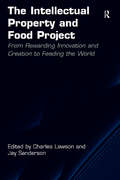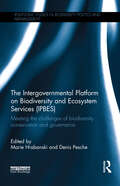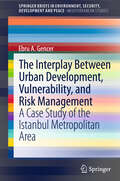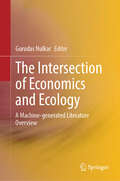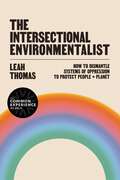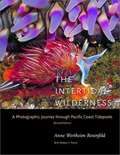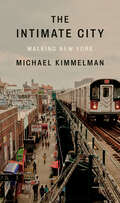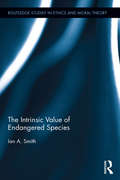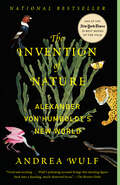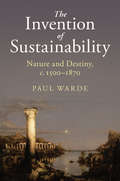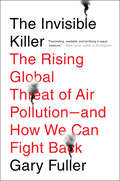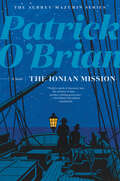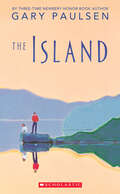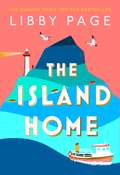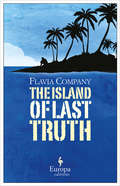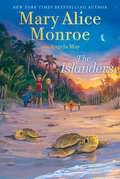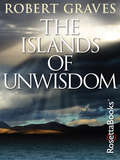- Table View
- List View
The Intellectual Property and Food Project: From Rewarding Innovation and Creation to Feeding the World
by Jay Sanderson Charles LawsonThe relationship between intellectual property and food affects the production and availability of food by regulating dealings in products, processes, innovations, information and data. With increasingly intricate relations between international and domestic law, as well as practices and conventions, intellectual property and food interact in many different ways. This volume is a timely consideration and assessment of some of the more contentious and complex issues found in this relationship, such as genetic technology, public research and food security, socio-economic factors and the root cause of poverty and patent-busting. The contributions are from leading scholars in this emerging field and each chapter foregrounds some of the key developments in the area, exploring historical, doctrinal and theoretical issues in the field while at the same time developing new ideas and perspectives around intellectual property and food. The collection will be a useful resource in leading further discussion and debate about intellectual property law and food.
The Intelligence of Flowers
by Maurice MaeterlinckWinner of the 2008 Prix de la Traduction Littéraire presented by French Community of BelgiumThe second of Maeterlinck's four celebrated nature essays—along with those on the life of the bee, ant, and termite—"The Intelligence of Flowers" (1907) represents his impassioned attempt to popularize scientific knowledge for an international audience. Writing with characteristic eloquence, Maeterlinck asserts that flowers possess the power of thought without knowledge, a capacity that constitutes a form of intelligence. Appearing one hundred years after the first publication, Philip Mosley's new translation of the original French essay, and the related essay "Scents," maintains the verve of Maeterlinck's prose and renders it accessible to the present-day reader. This is a book for those who are excited by creative encounters between literature and science as well as current debates on the relationship of humankind to the natural world.
The Interdependence of the Convention on the Rights of the Child: Understanding the Relationship of the Right to Play with other Convention Rights
by Naomi LottThe book critically engages with the right to play and other Convention rights to explore their interdependence and interconnectivity. The book brings together experts across various children&’s rights topics and invites them to consider the intersections of their work with the child&’s right to play. It furthers the understanding and implementation of the right to play as this novel area of research develops. The book demonstrates both the interdependence of the rights within the Convention, and the unique and critical role of the right to play in achieving the aims of the Convention and the rights therein. It also extends the theoretical, methodological and critical scope of the discipline by considering children&’s rights in this interdependent manner. The contributions to this edited collection explore the role of the right to play in meeting obligations pertaining to the digital environment, identity rights, education, climate change and environmental health, refugees, girls&’ rights, social protection, healthcare and disability, and vice versa. By drawing together original and creative approaches to a number of pressing social questions and issues relating to human rights, this book has tangible application for developing both the content of the right to play and the potentials of this right for the wider child rights project. Furthermore, this book is pioneering in the field of children&’s rights in two key ways. Not only does it serve to contribute to filling a significant gap in the literature on the right to play, but it also stands as a crucial example of interdisciplinary legal research. Such an approach is critical for the field of children&’s rights due to the nature of childhood and the multidisciplinary relevance of children&’s rights and children&’s issues. This book thus serves as an example to push the field to be more contextual and interdisciplinary.
The Intergovernmental Platform on Biodiversity and Ecosystem Services: Meeting the challenge of biodiversity conservation and governance (Routledge Studies in Biodiversity Politics and Management)
by Marie Hrabanski Denis PescheTwenty years after the Convention on Biological Diversity (CBD) entered into force, the founding of the Intergovernmental Platform on Biodiversity and Ecosystem Services (IPBES) in 2012 was the outcome of a long process of setting biodiversity issues at the top of the global environmental agenda. With contributions from more than a dozen well-renowned researchers in political science, law and sociology, this book analyzes IPBES functioning and challenges in terms of the knowledge selection process and actors involved. The book reveals that, through its conceptual framework, IPBES promotes a pluralistic view of nature that calls for a broadening of the disciplinary frontiers. It combines natural science and social science research and also includes indigenous and local knowledge. IPBES is considered to represent the institutionalization of a permanent knowledge assessment on biodiversity and is often referred to as an IPCC success story, constituting a new stage in global environmental governance. In analyzing the knowledge selection process for IPBES decision making, the book better situates IPBES within the biodiversity and global governance domain. It ultimately argues that the establishment of IPBES provides a new opportunity to coordinate the different international conventions (CBD, RAMSAR, CITES, etc.) and initiatives (international assessment of marine biology, scientific programs, funding, etc.).
The International African Library: Raiding Politics In The Central African Republic (The\international African Library #61)
by Louisa LombardThe International Law of Transboundary Groundwater Resources (Earthscan Water Text)
by Gabriel EcksteinThis book provides a comprehensive review of the state of international law as it applies to transboundary groundwater resources and aquifers. The main focus is on recent developments and the emerging international law for transboundary aquifers as reflected in the practice of states and the work of the UN International Law Commission, UN Economic Commission for Europe, and International Law Association. The author takes an interdisciplinary approach to the subject matter and provides the scientific hydro-geological underpinning for the application of law and policy to transboundary groundwater resources. He also addresses the growing global dependence on this hidden resource, as well as both the historical and scientific context for development of the law. The book provides case examples throughout to illustrate the various concepts and developments. These include more detailed examinations of the few existing transboundary aquifer agreements in operation, such as for aquifers between France and Switzerland and Jordan and Saudi Arabia, as well as aquifers in North Africa and in South America.
The Interplay between Urban Development, Vulnerability, and Risk Management
by Ebru A. GencerNatural disasters are increasingly affecting the world, taking lives unexpectedly and leaving many others injured and homeless. Moreover, disasters disrupt local, national and even global economies, instantly changing the direction of development. In the first half of 2011 alone, 108 natural disasters occurred, killing over 23 thousand people, affecting nearly 44 million others and causing more than 253 billion US dollars of economic damages (CRED 2011,1). Large urban settlements have become increasingly vulnerable to the impacts of natural disasters. The concentration of substandard infrastructure and housing, material assets, and inherent socio-economic inequalities increase vulnerability to disasters in large urban areas, especially in developing countries. The size, number, functions, and geographical distribution of large- and megacities create a special concern for disaster risk. Good urban management practices can be a powerful catalyst for reducing losses from natural disasters, while simultaneously helping to develop a sustainable environment. Yet, the existing situation indicates that sustainable planning and risk management measures are not taken into consideration or may not be put into practice for a variety of financial, political, and social reasons. This book argues that, on one hand, socio-economic disparities resulting from unsustainable urban development can increase vulnerability to natural hazards, and on the other hand, when paired with natural hazards this increased vulnerability can negatively affect urban areas, resulting in further inequality. This book will showcase this argument with theoretical reviews and quantitative analyses on the interplay between sustainable development and disaster vulnerability as well as an in-depth case study of the role of urban planning and risk management practices in creating the socio-economic and spatial vulnerabilities and predicted earthquake risk in the megacity of Istanbul.
The Interrupted Forest: A History of Maine's Wildlands
by Neil RoldeAdd to this the thousands of farms that have grown back to woods since the Civil War, and you have the most forested state, by percentage, in the United States. But the &“uninterrupted forest&” that Henry David Thoreau first saw in the 1840s was never exactly that. Loggers had cut it severely, European settlers had gnawed into it, and, much earlier, native people had left their mark. This book takes you deep into the past to understand the present, allowing you to hear the stories of the people and events that have shaped the woods and made them what they are today.
The Intersection of Economics and Ecology: A Machine-generated Literature Overview
by Gurudas NulkarThis book is a machine-generated literature overview highlighting the importance of natural capital while studying the economics of ecology. It puts together available literature on this theme exploring it through the lens of sustainable development. While the main content is machine-generated, each chapter contains curated published content overview and an introduction by the editor, highlighting important areas and literature gaps, describing the connection of the topic with human economy, and examples of negative externalities. The topics seek out research articles that show a connection with mainstream economy, or rural livelihoods.The connection between natural capital and human economy, is well-known, but many of these negative externalities are complex problems to solve. While there is a growing awareness to capture the value of natural capital in economic decision-making, there is no universal consensus. However, assessing the economic value of naturalresources and ecosystem services, and integrating this information into decision-making processes such as cost-benefit analysis, corporate reporting, and government policy-making, holds a promise of finding long-term solutions to these market failures. By valuing natural capital, decision-makers can better understand the economic benefits and costs of different activities and policies, and make more informed choices that balance economic, social, and environmental objectives. Containing important introductions by the human editor to plug gaps in literature, the book is a great resource for policy-makers, students of economics and sustainable development, non-governmental organisations working in this field, and corporate managers who are responsible for allotting budgets towards corporate social responsibility programs.^
The Intersectional Environmentalist: How to Dismantle Systems of Oppression to Protect People + Planet
by Leah ThomasFrom the 2022 TIME100 Next honoree and the activist who coined the term comes a primer on intersectional environmentalism for the next generation of activists looking to create meaningful, inclusive, and sustainable change. The Intersectional Environmentalist examines the inextricable link between environmentalism, racism, and privilege, and promotes awareness of the fundamental truth that we cannot save the planet without uplifting the voices of its people -- especially those most often unheard. Written by Leah Thomas, a prominent voice in the field and the activist who coined the term "Intersectional Environmentalism," this book is simultaneously a call to action, a guide to instigating change for all, and a pledge to work towards the empowerment of all people and the betterment of the planet. Thomas shows how not only are Black, Indigenous and people of color unequally and unfairly impacted by environmental injustices, but she argues that the fight for the planet lies in tandem to the fight for civil rights; and in fact, that one cannot exist without the other. An essential read, this book addresses the most pressing issues that the people and our planet face, examines and dismantles privilege, and looks to the future as the voice of a movement that will define a generation.
The Intertidal Wilderness: A Photographic Journey Through Pacific Coast Tidepools
by Anne Wertheim RosenfeldThe Intertidal Wilderness is a stunning photographic exploration of the tidepools of the Pacific coast, from Baja California to as far north as southeast Alaska. These lush photographs capture in striking color the enormous variety of life and biological detail in the intertidal zone along one of the world's most spectacular coastlines.
The Intimate City: Walking New York
by Michael KimmelmanFrom the New York Times architecture critic, his celebrated walking tours of New York City, now expanded, covering four of the five boroughs and some 540 million years of history, accompanied by some of the people who know it bestAs New York came to a halt with COVID, Michael Kimmelman composed an email to a group of architects, historians, writers, and friends, inviting them to take a walk. Wherever they liked, he wrote—preferably someplace meaningful to them, someplace that illuminated the city and what they loved about it. At first, the goal was distraction. At a scary moment when everything seemed uncertain, walking around New York served as a reminder of all the ways the city was still a rock, joy, and inspiration. What began with a lighthearted trip to explore Broadway&’s shuttered theater district and a stroll along Museum Mile when the museums were closed soon took on a much larger meaning and ambition. These intimate, funny, richly detailed conversations between Kimmelman and his companions became anchors for millions of Times readers during the pandemic. The walks unpacked the essence of urban life and its social fabric—the history, plans, laws, feats of structural engineering, architectural highlights, and everyday realities that make up a place Kimmelman calls &“humanity&’s greatest achievement.&” Filled with stunning photographs documenting the city during the era of COVID, The Intimate City is the ultimate insider&’s guide. The book includes new walks through LGBTQ Greenwich Village, through Forest Hills, Queens, and Mott Haven, in the Bronx. All the walks can be walked, or just be read for pleasure, by know-it-all New Yorkers or anyone else. They take readers back to an age when Times Square was still a beaver pond and Yankee Stadium a salt marsh; across the Brooklyn Bridge, for green tea ice cream in Chinatown, for momos and samosas in Jackson Heights, to explore historic Black churches in Harlem and midcentury Mad Men skyscrapers on Park Avenue. A kaleidoscopic portrait of an enduring metropolis, The Intimate City reveals why New York, despite COVID and a long history of other calamities, continues to inspire and to mean so much to those who call it home and to countless others.
The Intrinsic Value of Endangered Species (Routledge Studies in Ethics and Moral Theory)
by Ian A. SmithWhy save endangered species without clear aesthetic, economic, or ecosystemic value? This book takes on this challenging question through an account of the intrinsic goods of species. Ian A. Smith argues that a species’ intrinsic value stems from its ability to flourish—its organisms continuing to reproduce successfully and it avoiding extinction—which helps to demonstrate a further claim, that humans ought to preserve species that we have endangered. He shows our need to exercise humility in our relations with endangered species through the preservation of their intrinsic goods, which in turn rectifies our degradation of their importance. Unique in its appeal to virtue ethics and to species concepts, The Intrinsic Value of Endangered Species is an important resource for scholars working in environmental ethics and the philosophy of biology.
The Invention of Nature: Alexander von Humboldt's New World
by Andrea WulfThe acclaimed author of Founding Gardeners reveals the forgotten life of Alexander von Humboldt, the visionary German naturalist whose ideas changed the way we see the natural world--and in the process created modern environmentalism.NATIONAL BEST SELLEROne of the New York Times 10 Best Books of the YearWinner of the Los Angeles Times Book Prize, The James Wright Award for Nature Writing, the Costa Biography Award, the Royal Geographic Society's Ness Award, the Sigurd F. Olson Nature Writing AwardFinalist for the Andrew Carnegie Medal for Excellence in Nonfiction, the Kirkus Prize Prize for Nonfiction, the Independent Bookshop Week Book AwardA Best Book of the Year: The New York Times, The Atlantic, The Economist, Nature, Jezebel, Kirkus Reviews, Publishers Weekly, New Scientist, The Independent, The Telegraph, The Sunday Times, The Evening Standard, The SpectatorAlexander von Humboldt (1769-1859) was an intrepid explorer and the most famous scientist of his age. In North America, his name still graces four counties, thirteen towns, a river, parks, bays, lakes, and mountains. His restless life was packed with adventure and discovery, whether he was climbing the highest volcanoes in the world or racing through anthrax-infected Siberia or translating his research into bestselling publications that changed science and thinking. Among Humboldt's most revolutionary ideas was a radical vision of nature, that it is a complex and interconnected global force that does not exist for the use of humankind alone. Now Andrea Wulf brings the man and his achievements back into focus: his daring expeditions and investigation of wild environments around the world and his discoveries of similarities between climate and vegetation zones on different continents. She also discusses his prediction of human-induced climate change, his remarkable ability to fashion poetic narrative out of scientific observation, and his relationships with iconic figures such as Simón Bolívar and Thomas Jefferson. Wulf examines how Humboldt's writings inspired other naturalists and poets such as Darwin, Wordsworth, and Goethe, and she makes the compelling case that it was Humboldt's influence that led John Muir to his ideas of natural preservation and that shaped Thoreau's Walden. With this brilliantly researched and compellingly written book, Andrea Wulf shows the myriad fundamental ways in which Humboldt created our understanding of the natural world, and she champions a renewed interest in this vital and lost player in environmental history and science.From the Hardcover edition.
The Invention of Sustainability: Nature and Destiny, c.1500–1870
by Paul WardeThe issue of sustainability, and the idea that economic growth and development might destroy its own foundations, is one of the defining political problems of our era. This ground breaking study traces the emergence of this idea, and demonstrates how sustainability was closely linked to hopes for growth, and the destiny of expanding European states, from the sixteenth century. Weaving together aspirations for power, for economic development and agricultural improvement, and ideas about forestry, climate, the sciences of the soil and of life itself, this book sets out how new knowledge and metrics led people to imagine both new horizons for progress, but also the possibility of collapse. In the nineteenth century, anxieties about sustainability, often driven by science, proliferated in debates about contemporary and historical empires and the American frontier. The fear of progress undoing itself confronted society with finding ways to live with and manage nature.
The Invisible Killer: The Rising Global Threat of Air Pollution-and How We Can Fight Back
by Gary FullerAn urgent examination of one of the biggest global crises facing us today--air pollution--looking at the drastic worsening of the problem, and what we can do about it."Fascinating, readable, and terrifying in equal measure." —Mark Lynas, author of Six DegreesThe air pollution that we breathe every day is largely invisible—but it is killing us. How did it get this bad, and how can we stop it? Far from a modern-day problem, scientists were aware of the impact of air pollution as far back as the seventeenth century. Now, as more of us live in cities, we are closer than ever to pollution sources, and the detrimental impact on the environment and our health has reached crisis point. The Invisible Killer will introduce you to the incredible individuals whose groundbreaking research paved the way to today's understanding of air pollution, often at their own detriment. Gary Fuller's global story examines devastating incidents from London's Great Smog to Norway's acid rain; Los Angeles's traffic problem to wood-burning damage in New Zealand. Fuller argues that the only way to alter the future course of our planet and improve collective global health is for city and national governments to stop ignoring evidence and take action, persuading the public and making polluters bear the full cost of the harm that they do. The decisions that we make today will impact on our health for decades to come. The Invisible Killer is an essential book for our times and a cautionary tale we need to take heed of.
The Ionian Mission (Aubrey/Maturin Novels #8)
by Patrick O'BrianJack Aubrey and Stephen Maturin, veterans now of many battles, return in this novel to the seas where they first sailed as shipmates. But Jack is now a senior captain commanding a line-of-battle ship in the Royal Navy's blockade of Toulon, and this is a longer, harder, colder war than the dashing frigate actions of his early days. A sudden turn of events takes him and Stephen off on a hazardous mission to the Greek Islands, where all his old skills of seamanship and his proverbial luck when fighting against odds come triumphantly into their own.
The Ionosphere with GNSS SDR: Specialized Software-Defined Radio for In-Depth Ionospheric Research (Springer Atmospheric Sciences)
by Ivan G. Petrovski IIThis comprehensive volume navigates through the complexities of Earth's ionosphere and its intricate relationship with GNSS spread-spectrum signals. The book delineates the nuanced structures and dynamics of Earth's atmosphere, offering profound insights into signal propagation, including a meticulous analysis of various ionospheric models. Delving into the instruments of choice, it encapsulates the facets of the GNSS space segment, its theoretical background, and practical applications. The ground and user segments discussed provide readers with a deep understanding of satellite dynamics and navigation data. Further chapters explore the intricacies of GNSS Software Defined Radio (SDR), offering a detailed examination of signal acquisition and tracking, and presenting innovative approaches to baseband data application without data decoding. A significant portion is devoted to manufacturing front-end hardware, providing guidance from specifications to testing, enabling readers to navigate the world of hardware design with ease. Lastly, the book ventures into the applications of GNSS receivers for ionospheric study, highlighting the construction of advanced observables and their practical applications in navigation processors. This section also elucidates the role of multi-station observables in extracting critical ionospheric information. A pivotal resource for researchers and professionals alike, this book stands as a testament to comprehensive research and innovation in the field of GNSS and SDR, fostering a deeper understanding of the Earth's ionosphere. This book serves as a natural progression from Dr.Petrocski's prior contributions, offering readers actionable insights grounded in theoretical understanding.
The Island (Point Ser.)
by Gary PaulsenFrom the New York Times–bestselling author of Northwind, a unique exploration into the exhilarating joys—and the inevitable dangers—of total solitude.Every day, fifteen-year-old Wil Neuton gets up, brushes his teeth, leaves the house, and rows away from shore. He’s discovered the island, a place where he can go to be alone and learn to know nature—and himself.Wil’s only mission is to let go of the outside world. But the outside world refuses to let go of him. His family regards him as a puzzle. The town bully is determined to challenge him. And suddenly, even reporters know his name. He can confront them all, or he can embrace his solitude forever. Just one thing is certain now: Wil Neuton will no longer be relying on anybody but himself.“This could have been another back-to-nature story, but Newbery Honor writer Paulsen tells Wil’s inner journey with a confident lyricism that duplicates Wil’\’s emotional qualities.” —Publishers Weekly“Wil Neuton seeks out harmony within [nature], recalibrating his life by way of his self-imposed solitude on the island . . . While Hatchet provided readers with some much-needed escapism, The Island centered its focus on what we can never escape—mortality, which, in the immediate aftermath of Paulsen’s passing, now takes on new significance.” —The Millions
The Island Chumash: Behavioral Ecology of a Maritime Society
by Douglas J. KennettAn archaeological and climatological analysis of how environmental change affected the evolution of social complexity among Chumash hunter-gatherers of southern California.
The Island Home: The uplifting page-turner making life brighter in summer 2021
by Libby PageTwo decades. Hundreds of miles. A lifetime of secrets. Can coming home mean starting again?'A perfect, warm escape from these cold, dark times' Kate Eberlen 'Bursting with hope and heart' Cathy Bramley 'Wonderfully engaging . . . beautifully drawn' Mike Gayle 'Radiates warmth, happiness and hope' Veronica Henry ----- Lorna's world is small but safe. She loves her daughter, and the two of them is all that matters. But after nearly twenty years, she and Ella are suddenly leaving London for the Isle of Kip, the tiny remote Scottish island where Lorna grew up. Alice's world is tiny but full. She loves the community on Kip, her yoga classes drawing women across the tiny island together. Now Lorna's arrival might help their family finally mend itself - even if forgiveness means returning to the past... ----- Join the community of bestselling authors who love Libby's hopeful, moving storytelling! 'A wonderfully evocative and enveloping novel about the joys and comforts of community and friendship and a perfect, warm escape from these cold, dark times' Kate Eberlen, author of Miss you and Only You 'A tender tale about stepping out of the shadows of the past and navigating the route to a brighter future....this book not only takes the reader on a journey, but reminds us of the importance of finding our way back home' Mike Gayle, author of All The Lonely People 'The Island Home radiates warmth, happiness and hope. Libby is a truly gifted writer who weaves magic with her every word. Every page is a delight - gentle, comforting, reassuring and utterly charming' Veronica Henry, author of The Beach Hut series 'A tender, life-affirming story bursting with hope and heart' Cathy Bramley, author of My Kind of Happy 'A joy-filled love letter to the power of community and connection, and a sensitive commentary on loneliness and forgiveness too, all of which is conveyed with huge warmth and affection' Celia Reynolds, author of Finding Henry Applebee 'A tender, heartfelt story, The Island Home explores every aspect of love and shows us it's never too late to fix what's broken. I left my heart with Lorna and Alice on the Isle of Kip' Lindsey Kelk, author of In Case You Missed It 'A gorgeous, heart-lifting story of families and the secrets that bind us, with a setting that you can lose yourself in' Rachael Lucas, author of The Village Green Bookshop
The Island of Last Truth
by Flavia CompanyA novel of adventure, survival, and psychological suspense with “a surprise ending worthy of Hitchcock” (Publishers Weekly).Legend in the academic world has it that Dr. Matthew Prendel, an expert sailor, had been shipwrecked years ago. His boat was attacked by pirates. He survived thanks to an incredible stroke of luck while his entire crew perished, but then found himself embroiled in a ferocious fight for survival between two castaways on a desert island. There, too, he was lucky and came out the victor.But perhaps luck played no part in it. Perhaps something darker was at play, something bigger at stake. The only sure thing is that Matthew Prendel disappeared for five whole years. He has been back in New York now for a while, or so they say. One should never rely entirely on hearsay . . .A blend of adventure story and noir mystery, The Island of Last Truth is a riveting tale filled with both suspense and incisive psychological observation.
The Islanders (The Islanders #1)
by Mary Alice MonroeAn instant New York Times bestseller! &“Storytelling for young readers at its finest—equal parts summer adventure and environmental suspense…[a] love letter to family, friendship, and the natural world.&” —Kwame Alexander, New York Times bestselling author of The Crossover From New York Times bestselling author Mary Alice Monroe comes a beautiful story of friendship, loss, and the healing power of nature in her first book for middle grade readers.Eleven-year-old Jake&’s life has just turned upside-down. His father was wounded in Afghanistan, and his mother is going to leave to care for him. That means Jake&’s spending the summer on tiny Dewees Island with his grandmother. The island is a nature sanctuary—no cars or paved roads, no stores or restaurants. To make matters worse, Jake&’s grandmother doesn&’t believe in cable or the internet. Which means Jake has no cell phone, no video games...and no friends. This is going to be the worst summer ever! He&’s barely on the island before he befriends two other kids—Macon, another &“summer kid,&” and Lovie, a know-it-all who lives there and shows both Jake and Macon the ropes of life on the island. All three are struggling with their own family issues and they quickly bond, going on adventures all over Dewees Island. Until one misadventure on an abandoned boat leads to community service. Their punishment? Mandatory duty on the Island Turtle Team. The kids must do a daily dawn patrol of the beach on the hunt for loggerhead sea turtle tracks. When a turtle nest is threatened by coyotes, the three friends must find a way to protect it. Can they save the turtle nest from predators? Can Jake&’s growing love for the island and its inhabitants (be they two-legged, four-legged, feathered, or finned) help to heal his father?
The Islands of Unwisdom
by Robert GravesSwashbuckling historical fiction from the author of I, Claudius. &“A cleverly balanced mixture of spice, fact, humor and adventure on and off the high seas&” (Kirkus Reviews). Set in the Age of Exploration, The Islands of Unwisdom tells the story of the ill-fated Don Álvaro de Mendaña y Neyra, a Spanish explorer set on finding the Solomon Islands, the mythical source of King Solomon&’s vast wealth. Driven by greed, ambition, and lust, Don Alvaro and his wife, the beautiful and dangerous Ysabel, lead a crew of adventurers beyond the horizon in search of the wealth of their wildest dreams. However, that&’s not exactly what they find. In the hands of master historical novelist, classicist, and poet Robert Graves, this tale offers a fascinating look at a brutal and bloody era, and insights into the reasons for Spain&’s failure to ultimately dominate world exploration during this time.
The Ivory-Billed Woodpecker (Dover Birds Ser.)
by James T. TannerLong thought extinct, the elusive Ivory-billed Woodpecker was rediscovery in a remote region of Arkansas. This book is a fascinating and comprehensive study of the remarkable bird. It was originally published by the National Audubon Society in 1942 when the Ivory-bill's survival was in danger and only few of the species could still be found in the southern United States. It opens with a general description (explaining how to distinguish the Ivory-bill from its more commonly encountered cousin, the Pileated Woodpecker), and offers an extensive profile of the species' other characteristics and habits, including its original distribution patterns, the history of its disappearance, and its feeding, nesting, and breeding habits.
